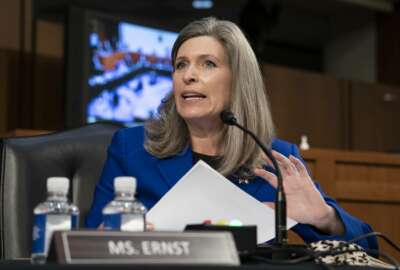Why the State Department wants to set up federally-funded research and development centers
Industry was puzzled by the State Department's plan to establish three federally-funded research and development centers, FFRDCs.
In a recent interview with an executive of the industry group, the Professional Services Council, I discussed the State Department’s plan to establish three federally-funded research and development centers, FFRDCs. Industry was puzzled by this move because of the nature of State Department’s requirement, facilitate public private collaboration for numerous activities related to diplomacy and modernization. Joining the Federal Drive with Tom Temin with the State Department’s view, the Deputy Assistant Secretary for Acquisition and Senior Procurement Executive, Michael Derrios.
Interview transcript:
Tom Temin Mr. Derrios, good to have you in studio.
Michael Derrios Hi, Tom, thanks for having me.
Tom Temin Let’s begin at the beginning. FFRDCs, you have a RFQ out now for three of them. Tell us the purpose here.
Michael Derrios Sure. And actually, I’ll clarify, it’s actually not an RFQ, we’re not quite there to that part of the process. So, this is the federal register process where we have a 90-day clock. We’re taking in public comments during the period. And then at the end of that process, we’ll be putting out an RFP. I want to stress that point because I think that that’s probably something that industry and trade associations should think about. So, what you see right now in those very broad-scoped buckets, if you will, in that notice, is really just again, broad language that describes what the centers would would do in an R&D environment for the mission set. The specific requirements are going to be contained in that RFP at the end of the public comment period.
Tom Temin But at first glance, you think of FFRDCs for scientific-related agencies, looking for partners, typically non-profits, the miters, and so forth of the world to do research in scientific technical areas. State Department is loosey-goosey, diplomacy in getting along with people, advising military. So, give us the vision here.
Michael Derrios I’m so glad that you actually mentioned that, Tom. I think that a lot of people don’t actually know about the the real robustness of the mission set. When you when you think about R&D, and what, well, actually, you know what, let me start here. We use FFRDCs today. This is not a new thing for us. We’re already leveraging FFRDCs through other agencies, so, Treasury, DHS, etc. What’s new for us is wanting to sponsor agreements with FFRDCs for the first time directly. So, the usage of FFRDCs is definitely not new for the department. And that’s because we absolutely have requirements that fit that space. If you think about diplomatic security, or INL, International Narcotics and Law Enforcement. We also have a bureau focused on paramilitary affairs. We actually have an office of science and technology. So, you know, the mission set is actually much broader than I think a lot of people realize. A lot of folks kind of associate the bigger bureaus like Consular Affairs, which would also have, I think, some requirements that would fit in this space, or Diplomatic Security, formerly known as IRM. There are a variety of areas across the mission set that I think would would benefit from direct usage of FFRDCs. And just to kind of peel back the layer of the onion a little bit more, we’re trying to solve for three problems. Essentially, it’s scope, it’s ceiling, and it’s expedited access. When we leverage FFRDCs through other agencies, we have to use the interagency process for that. So, there’s a lot of documentation that goes into that.
Tom Temin A lot of bureaucracy.
Michael Derrios Absolutely, absolutely. Oftentimes, we are challenged with trying to fit our scope into the nature of their vehicles, make sure that it’s a clean fit. In some cases, that could mean that we are cutting our requirements to try to fit into their box, if you will. And then the other piece of it is ceiling. Rightfully so, any agency is going to scrutinize the ceiling on their vehicle, because the dollar. They want to make sure that they can support their internal customer base and you know, and others if they do support other agencies, but they’re going to protect the scope and the ceiling mostly on their vehicles, very tightly, as they should. We have seen where we’ve been kicked off of vehicles because of ceiling issues, right? And then you’ve touched on it, the bureaucracy. So, getting access, just getting on the vehicle can sometimes be a very elongated process. You’re talking about interagency documents that have to be signed on both sides. Again, there’s that negotiation about the scope and the ceiling. And sometimes it could be months before we’re actually able to tap into one of the vehicles. So, by issuing direct sponsoring agreements, we’re trying to solve for those three issues. And most importantly, I would say, structure agreements with FFRDCs that are very unique and tailored to what we need.
Tom Temin We’re speaking with Michael Derrios. He’s deputy assistant secretary of state for acquisition and the senior procurement executive. And, for the FFRDC types of requirements that could be filled that way, where do your demand signals come from? Is it from those areas you mentioned, diplomatic security, paramilitary office?
Michael Derrios Yeah, great question. Frankly, I think a variety of the bureaus in the department would be users. I’ve been contacted twice in the last month from offices that are asking, hey, Mike, is ready to go yet? We’re actually nowhere near being ready to go yet. That’s an indication of how much interest there is. And we obviously did the, we looked at how much usage we have today. Through the interagency process, we’ve done some pulsing. So, we know that there’s definitely a demand signal. I think there’s a variety of organizations that could use it. So, the benefit of an FFRDC arrangement is that it gives us the ability to enter into a kind of trusted relationship with a nonprofit organization. And the FAR actually encourages us to have a long term relationship. And also, it’s the ability to share information and data that we can’t always share with for-profit companies for a variety of reasons.
Tom Temin Because that was one of my questions. Are some of these things, could they ordinarily be done by some of the big, broad based contractors, the Lighthouses or the SAICs of the world?
Michael Derrios Sure, yeah. So, we’re going to be governing the process very tightly. We’re going to establish an apparatus to make sure that as requirements come in, we’re vetting those and that we know that they’re a good fit, number one, for R&D work. And, then, the customer, you know, is actually wanting to use the right center within the construct. And, then, three, is this a fit for industry? There’s actually two key words, when you look at FAR part 35 and the policy that describes FFRDCs. Actually, two key words. It talks about, you know, whether or not industry can as effectively do the work. I think those two words actually offer us a lot of broad latitude to make that determination. I’m not a requirements owner, but I’m going to illustrate, you know, potential requirements for you right to try to explain that. So, I don’t think it’s out of the realm of possible for diplomatic security to come to us and say, hey, we’re interested in R&Ding some security solutions, right? And maybe we would want to feed in FFRDC threat information that we couldn’t necessarily share with a for-profit company, right? To help us develop and prototype something unique for diplomatic security. You can say the same thing for potentially cyber missions across the department. Variety of different organizations, kind of, you know, collectively own that. Intel and INR, you know, intelligence. There could be a need.
Tom Temin Yeah, I was wondering about the paramilitary, thinking about something that’s kind of been wiped off of the front pages, so to speak. And that’s what’s going on in Haiti. Unfortunately, the nation has focused on the President’s mental acuity or whatever that might be, instead of issues like Haiti, which I think is still festering.
Michael Derrios Yes. And we’re actually, the State Department is very actively involved in the situation with Haiti. Can’t speak on the broader issue you raised, but definitely, whether it’s studies—
Tom Temin It’s just dealing with that weird situation where you write government that has a rival that’s as powerful as the government, in this kind of distributed paramilitary situation.
Michael Derrios Right, and the ability to possibly tap into an FFRDC that could offer some very technical knowledge and help us study a problem set and potentially propose alternative approaches to addressing something, right? And that’s the kind of work that we’re talking about. So the need is absolutely there. I would say to trade associations, and in our industry partners, bear with us. Take a look at the RFP when it comes out, and offer a little bit of trust. We are going to put a very tight governance process on this. And if something is a much better fit for industry, we’re going to go in that direction.
Tom Temin Sure. And how do you budget for this? Because in some sense, an FFRDC functions in almost like an IDIQ mode. And so you have to know what your ceiling is, what state department’s ceiling will be, without knowing how much once it’s established, people could come running and saying, hey, we need this and that done.
Michael Derrios Now, that’s a fantastic point. So my policy shop is actually doing all of the outreach today to build a statement of objectives. And then we’re pulsing the department to figure out what we think those requirements might look like over a five-year period. And the way that FFRDCs work is we’re required to actually examine the usage after a five-year period and determine whether or not it makes sense to continue on with that relationship. But yeah, we’re definitely wanting to pulse right now to figure out what the ceiling should be set at for these vehicles, because, you’re right, they are IDIQs. It’s not a matter of, you know, forward funding anything. We’re going to fund at the task order level as requirements come in. But we definitely are trying to do that pulsing across the department today to figure out what the demand signal will be in terms of potential dollars.
Tom Temin All right, so, any other great procurement initiatives we should know about from state?
Michael Derrios I would say, you know, we are actually trying to get OTA authority as well, which I think you’re aware of.
Tom Temin Other transaction authority, uninitiated listening.
Michael Derrios Yeah. And the main thing there is to really to try to attract non-traditional companies to the mission set. We know that there are a variety of companies out there, especially small startups that offer some tremendous capability that just don’t always want to deal with the bureaucracy of a federal contract in its typical form. So, if we had the ability to tap into those companies, that would greatly expand our industrial base. So, we’re working on that as well.
Tom Temin All right, we’ll have to have you back when some of these things start to take concrete form.
Michael Derrios Happy to do it.
Tom Temin All right. Michael Barrios is deputy assistant secretary of state for acquisition and the senior procurement executive. Thanks so much for joining us.
Michael Derrios Thank you.
Tom Temin We’ll post this interview along with a link to more information at federalnewsnetwork.com/federaldrive. Subscribe to the Federal Drive wherever you get your podcasts.
Copyright © 2024 Federal News Network. All rights reserved. This website is not intended for users located within the European Economic Area.
Tom Temin is host of the Federal Drive and has been providing insight on federal technology and management issues for more than 30 years.
Follow @tteminWFED






